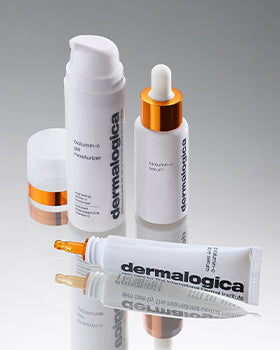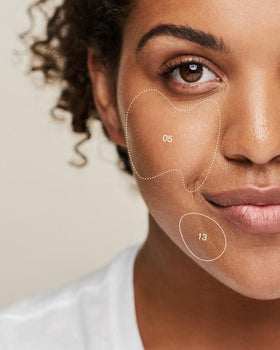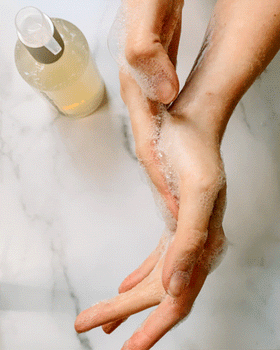Old acne leaving you with dark spots? Read on to learn more about the differences between types of skin spots and how to treat them.
Have you ever looked in the mirror and noticed a few dark spots where your pimples used to be, or just got back from your blissful 10-day holiday in the tropics only to find darker patches appearing on your face even after your tan fades? Then you might have battled with Hyperpigmentation or Post-Inflammatory Hyperpigmentation (PIH) and probably will again at some point. The two go hand in hand but not to worry, it's not all that uncommon and usually pretty harmless. Stay tuned because we're going over what hyperpigmentation and PIH actually are, how to treat them, and how you can avoid it altogether.
defining hyperpigmentation
The term "hyper" when used in medical terms means "more" or "excessive". "Pigment" means the colour of our skin. So, hyperpigmentation basically translates to "more pigment" and that pigment is melanin. Melanin is produced by our cells and is responsible for giving us our skin tone. When those cells overproduce melanin in certain areas, the skin will appear darker than our natural tone.
defining post-inflammatory-hyperpigmentation (PIH)
Let's get into PIH and how these two are similar but not quite the same. Post-inflammatory means "after inflammation" and in these circumstances, it just means "after a breakout". PIH is basically a type of hyperpigmentation you experience after a pimple has run its course. Those annoying dark spots left over from last week's breakout are actually called post-inflammatory hyperpigmentation.
PIH is temporary and only occurs after the skin cells have been damaged or irritated in some way. This is why picking pimples will only make things worse and prolong this process, so don't pick. Hyperpigmentation is not brought on by any sort of damage to the skin, and in some cases doesn't fade on its own.
treating hyperpigmentation vs. PIH
Hyperpigmentation and post-inflammatory hyperpigmentation have a few main differences. For instance, PIH is easier to treat with over-the-counter acne products.
hyperpigmentation
Hyperpigmentation is usually caused by either too much sun exposure, hormonal chances (such as pregnancy), certain medications like birth control, and recent studies have shown that even heat alone can cause hyperpigmentation for some of us. The safest way you can protect yourself from developing hyperpigmentation is sunscreen. If you're not wearing SPF every day but haven't developed any hyperpigmentation, that doesn't necessarily mean that it's not there. For some, the effects of hyperpigmentation from the sun don't show up for years down the road. Always protect your skin with sunscreen. If you think you might be dealing with hyperpigmentation from a medication like birth control or other hormonal chances, it's best to consult with your doctor so they can assess your situation. To summarise:
- A direct result of the overproduction of melanin.
- Occurs in patches or large areas.
- Can be caused by sun exposure, certain medications, pregnancy (Melasma), or other hormonal changes and age.
- Can be challenging to treat.
post-inflammatory hyperpigmentation
Post-inflammatory hyperpigmentation will appear on the skin as small dark spots. Unlike hyperpigmentation, which will appear in larger patches. PIH usually fades relatively quickly and only appears post-breakout. Some ingredients to help fade PIH fast are Salicylic Acid, Niacinamide, Vitamin C, AHA and BHA.
When it comes to treating hyperpigmentation, a common ingredient is Vitamin A, also known as Retinol. Getting regular chemical peels from your skin therapist can also be extremely beneficial for both PIH and hyperpigmentation. This speeds up cellular turnover rate, resulting in new cells and a brighter complexion. To summarise:
- Caused by inflammation or trauma to the skin (post-breakout).
- Appears as small dots. Usually brown, pink or red.
- Not permanent and fades quicker with the help of topical treatments such as Salicylic Acid, Vitamin C, Niacinamide and Glycolic Acid.
- Can be challenging to treat.
melanopro peel system: fade hyperpigmentation in 6 weeks or less

The Melanopro Peel System is a comprehensive skin care program to visibly reduce hyperpigmentation and skin tone irregularities. It is a 2-phase system. The first phase is done by a skin care professional in a skin center. The second phase is continued at home with prescribed products. Results will be seen in under 6 weeks.
First, a masque is applied by a professional in a skin center. This masque will need to stay on between 4-7 hours, with the exact duration determined by your skin care professional after a skin analysis. You will be given proper instructions on the removal process by your skin therapist. 24 hours (or later) after you remove the masque, you will begin to start using the prescribed home care products. You will keep using these until they are finished.
ingredients to help lighten hyperpigmentation and pih
Niacinamide
A form of Vitamin B3 or Niacin, Niacinamide can help lighten pigment while also helping with breakouts and can even be used on skin types with rosacea.
Retinoids
A derivative of Vitamin A, retinoids are highly effective in helping with not only pigmentation but also acne and fine lines and wrinkles. The ability to speed up the cellular turnover rate makes this ingredient an all-around great product for anti-ageing. Depending on its strength, some people may not be able to tolerate certain retinoid creams and may have to discontinue use if irritation occurs.
Azelaic Acid
A Dicarboxlic acid produced from yeast such as barley and wheat. This acid helps to quickly restore skin to its healthy state and can help treat acne as well as lighten dark spots.
so...
Treating hyperpigmentation and PIH definitely presents its challenges but on the bright side, both are treatable and preventable with proper skin care regimen and a little patience. Remember that preventing is always easier than treating, so invest in a good routine now to ensure you always have healthy and glowing skin. Sunscreen is your best friend (and a non-negotiable), and hats are essential when spending a prolonged time in the sun.
Learn more about Melanopro here.



